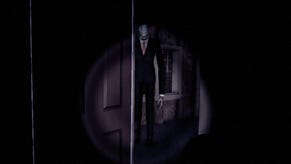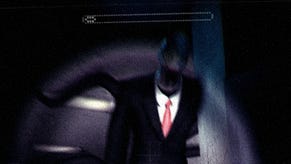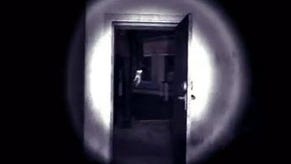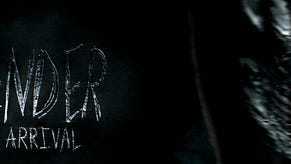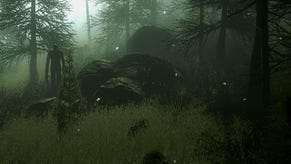Slender: The Arrival wants your soul
Slender: The Arrival is really scary. VG247's Dave Cook plays the terrifying beta and speaks with Blue Isle Studios to learn about true fear.
The PC development crowd is really putting triple-a horror games to shame recently. Resident Evil 6 was a pauper that begged, borrowed and pinched mechanics from the industry's wide selection box of ideas.
Capcom greedily scoffed the lot, except for horror - the 'coffee creme' of gaming.
Parsec Production's original game Slender: The Eight Pages nailed the fundamentals of what makes a horror experience genuinely unnerving. The game got it right.
It delivered a crippling sense of ambiguity, and the feeling that comes with facing an unclear, unstoppable entity like the Slender Man. It's like forcing a toddler and a starved mountain lion to fight to the death. You're the infant.
One aspect that really let the original game down – as intriguing as it was – were its visuals.
I realise Slender was made on a budget, but Blue Isle Studio's follow-up really does benefit from having more graphical tricks under the hood like static, eerie lighting and a marred depth of field.
You'll often see me on these very pages, bleating about how visuals rank behind gameplay as a secondary concern in games – and for the best part I truly believe that – but Slender: The Arrival is an exception to the rule.
I had a quick chat with Blue Isle's Alex Tintor about how his team approached the task of delivering this kind of effective horror without resorting to over-complication. “The Arrival is survival horror broken down into its most basic form,” he told me.
“We’ve taken the ideas of being isolated, alone, confused, and scared and we throw players into a scenario where we let them live out these human emotions. It’s all about immersion; step into the game world and make it real.
“It’s only once players can buy into this world that we can truly begin to scare them in really interesting ways. In short, there’s a lot more to this game than meets the eye.”
He's absolutely right, because all you do is wander a dense forest in the dead of night, searching for eight scrapbook pages that are dotted randomly around the environment. Your character stumbles around in the dark, camera in hand as they explore abandoned camp sites, ditched cars and dilapidated tool sheds.
The dense sandbox is menacing, the howling wind rips through your skull and the sound of twigs being snapped underfoot stabs like a knife to the heart. This really is a game that benefits from increased aesthetic clout. Don't ask me how it looks when your flashlight dies though, as it's too painful to relive.
Wherever you are the Slender Man is out there watching you. Sometimes he's hiding in plain sight or stalking you from behind. You'll know when he's near when your camera's display and static starts to warp and crackle loudly. Once that happens you have to run. Seriously, just run in the opposite direction or he'll kill you.
Tintor explained that these encounters are so random and unexpected in fact, that even his team can't predict when the Slender Man will emerge. “We’ve designed each scenario to happen differently each time you play,” he continued. “We as developers sometimes don’t even know what is going to happen.
“We’ve tried to craft an experience that is so unpredictable and dynamic, that the sense of panic and fear never wears off because it happens differently each time. With that said, we’ve spent a lot of time to carefully balance everything to allow for long moments of tension and build up, so when the moment finally hits, it has a huge impact.”
Because there's no map, you'll often turn around after escaping Slender Man, unsure of where you've ended up. Remember that scene in the Blair Witch Project where the group of kids double back on themselves and pass the same tree twice? This sense of disorientation will happen a lot as you play. It's not annoying, it's frighting.
The fact that Slender Man is always just two steps behind you creates immeasurable tension when you get lost like this. Worse still is when you see him spring up in your peripheral vision, readying his tentacles to strike as the screen fizzes and distorts violently.
I asked Tintor what he feels is the key to making a truly frightening experience, “I think there’s a lot of different way you can create a truly scary moment. We’ve taken an approach where we draw players into our world and let them become part of the game. We take seemingly normal looking environments and scenarios and add a touch of the unfamiliar.
“We try to draw players in by showing them things they can relate to, and then once they are immersed in our world, we shatter that sense of safety and familiarity. The other key is to create a sense of unknown; players should never be able to predict what is happening next and I think that’s what was so great about the original; totally unpredictable behaviour.”
Although Tintor explained that his team would love to bring Slender: The Arrival to consoles some day, it stands comfortably alongside the recent wave of superb horror games turning heads on the PC circuit. That's because it nails the fundamentals of the genre and wraps them around a simple premise. It's clear that fear comes first.
If you enjoy curious titles like Dear Esther, Amnesia: The Dark Descent and The Path, then you really should check out The Arrival. Granted, it'll make you never want to step foot in a forest again, but if anything that's testament to just how effectively Blue Isle gets under your skin.
Now if you'll excuse me, I have an abandoned camp site to investigate. If I'm not back in two days, send help.






